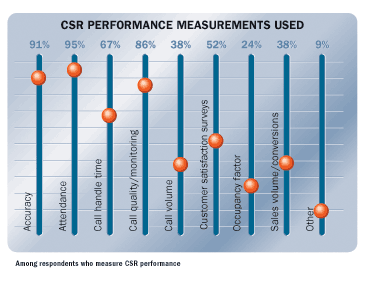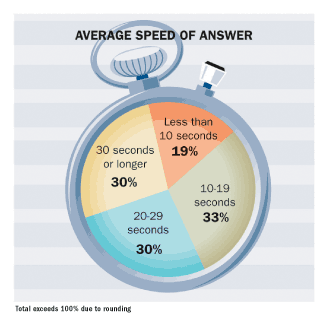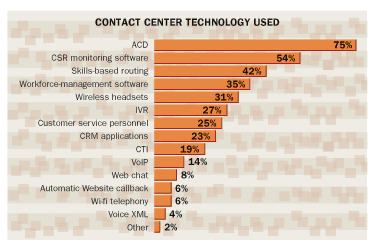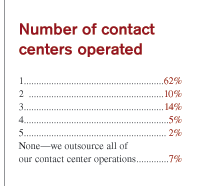Despite the importance of keeping customers happy, merchants still have a way to go when it comes to improving service levels. According to Multichannel Merchant/O+F’s 2006 Benchmark Report on Contact Center Operations, in several key metrics — average speed of call answer (ASA), average time in queue, and agent occupancy rate — respondents came up surprisingly short.

For example, for ASA, respondents aimed for a mean 14.0 seconds. But it actually took respondents a mean 22.6 seconds to answer a call. That’s a 14% decline in speed from our previous contact center survey, conducted two years ago. Among respondents to the 2004 survey, the mean ASA had been 19.8 seconds.

This year’s respondents missed their average time in queue targets as well. Though respondents had a mean target time in queue of 36.8 seconds, their callers actually spent a mean 40.5 seconds in queue, up significantly from the mean 29.9 seconds among respondents two years ago.
And the mean agent occupancy rate — defined as the percentage of time during a half-hour that agents on the phones are in talk time and after-call work — was only 63.8% among this year’s participants, significantly lower than the 70.6% that was their mean goal. It was also nearly 6% lower than the mean 67.6% occupancy rate achieved by respondents to the previous survey.
AVERAGE TALK TIME
At a mean 4.8 minutes, the averge talk time (ATT) among this year’s respondents is slightly longer this year, compared to a mean 4.6 minutes in 2004 and a mean 3.9 minutes in 2002. The increase may be a result of the Internet, interestingly enough, because many consumers do their research on the Web and then call the contact center to get specific questions answered. The callers will usually proceed to place the order with the customer service representative. So much for the Web eliminating the need for “live” service reps and order-takers.
CONTACT CENTER AVAILABILITY
In this wired age, you’d think 24-hour customer service would become more of a standard, but only 21% of respondents operate their contact center round the clock, and another 2% operate them 19-23 hours a day. A full half of respondents keep their contact centers open just 9-13 hours daily.
OUTSOURCING IN THE CONTACT CENTER
About 7% of respondents outsource all of their contact center operations, while 15% of respondents who operate contact centers say they outsource some of those center functions. What tasks are they most likely to outsource? Of those who outsource certain functions, 58% outsource inbound order-taking, 50% outsource customer service, and a third outsource so-called help-desk functions such as catalog requests. Among respondents to the 2004 survey, 72% had said they outsourced inbound order-taking, 21% outsourced customer service, and 28% said “other,” which could include catalog requests, order entry, and overflow of calls.
Among this year’s respondents who outsource contact center functions, 40% described themselves as “very satisfied” with their outsourcing relationships. Eighty percent of respondents who outsource do so within the U.S., with only 20% outsourcing overseas.
TECHNOLOGY TALK
Though change is gradual, more companies seem to be taking advantage of the available technology to gain a foothold on the competition. For example, 54% of respondents are monitoring their customer service reps via software, compared with 49% of the respondents in 2004. Another encouraging sign: More contact centers are using skills-based routing — a method of routing calls based on the caller’s needs or reason for calling. This year 42% of respondents said they use skills-based routing software, compared with 38% of those surveyed in 2004 and 36% in 2002.

Thirty-five percent of respondents use workforce management software, which predicts staffing requirements and creates schedules using data regarding the company’s service levels, metrics, and other business rules. This percentage slipped a statistically insignificant percentage point from 36% in 2004.
The vast majority — 75% — of respondents use automatic call distributors (ACDs), programmable devices that queue or route incoming calls to contact center agents, play prerecorded announcements, and provide real-time and historical reports on call activity. Voice over Internet Protocol (VoIP), which transmits phone conversations over the Web, providing companies with an alternative to telephone company long-distance services, is being used by 14% of respondents, up from 8% in 2004.
More common in contact centers are software solutions that allow customer service representatives to see a caller’s entire history with the company as they speak. Such tools are generally part of a customer relationship management (CRM) initiative. Nearly 23% of this year’s respondents said they use such CRM applications in their contact center — but that’s virtually unchanged from the 22% of respondents to the 2004 survey.
PAYMENT PLANS
The majority of respodents — 54% — pay their customer service reps on a per-hour basis, up from 40% of respondents two years ago. Another 26% compensate reps with a base salary plus a performance incentive, down from 36% in 2004. The remaining 20% pay a base salary only, as did 22% of the participants in the previous survey.
METHODOLOGY
On Jan. 11, 2006, Prism Business Media e-mailed 2,473 Multichannel Merchant subscribers, selected on an nth-name basis, an invitation to an online survey. The e-mail contained an embedded URL linking the recipients to the Website where the survey was located. Recipients were offered a chance to win one of four $50 gift certificates to Amazon.com. Follow-up e-mails were sent on Jan. 18 and Jan. 24. By Feb. 7, Prism Business Media had received 58 completed surveys; 356 of the outbound e-mails were undeliverable; and four surveys incomplete. The effective response rate was 2.7%.
- Six out of every 10 respondents say they measure CSR performance
- The mean call abandonment rate is 3.3% in 2006, higher than the 2.9% mean call abandonment rate in 2004, but lower than the 3.4% mean call abandonment rate in 2002.


